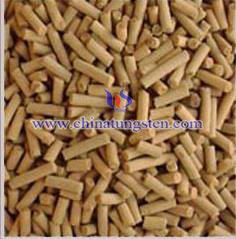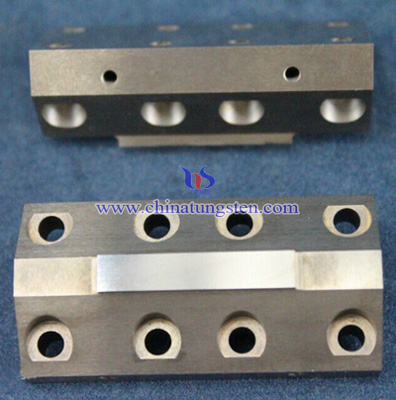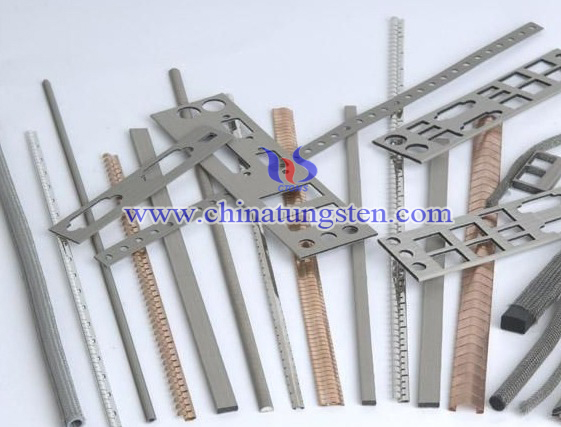WO3 Used in Hydrodesulfurization Catalyst
- Details
- Category: Tungsten Information
- Published on Tuesday, 26 April 2016 18:13
- Written by chunyan
- Hits: 253
 The WO3 hydrodesulfurization catalyst with nanoscale, high dispersion and activity which can be used in the process of distillate hydrodesulfurization, and carried out in a fixed bed reactor, at a reaction temperature of 200-400℃, pressure of 0.2-20MPa, its production steps are as follows:
The WO3 hydrodesulfurization catalyst with nanoscale, high dispersion and activity which can be used in the process of distillate hydrodesulfurization, and carried out in a fixed bed reactor, at a reaction temperature of 200-400℃, pressure of 0.2-20MPa, its production steps are as follows:| Tungsten Oxide Supplier: Chinatungsten Online www.tungsten-oxide.com | Tel.: 86 592 5129696; Fax: 86 592 5129797;Email:sales@chinatungsten.com |
| Tungsten News & Prices, 3G Version: http://3g.chinatungsten.com | Molybdenum News & Molybdenum Price: http://news.molybdenum.com.cn |
Doped Tungsten Bronze Niobate Crystal Structure
- Details
- Category: Tungsten Information
- Published on Tuesday, 26 April 2016 18:09
- Written by xinyi
- Hits: 265

| Tungsten Oxide Supplier: Chinatungsten Online www.tungsten-oxide.com | Tel.: 86 592 5129696; Fax: 86 592 5129797;Email:sales@chinatungsten.com |
| Tungsten News & Prices, 3G Version: http://3g.chinatungsten.com | Molybdenum News & Molybdenum Price: http://news.molybdenum.com.cn |
Steel Bonded Carbide Description (1/2)
- Details
- Category: Tungsten Information
- Published on Tuesday, 26 April 2016 15:33
- Written by xiaobin
- Hits: 304
From the narrow sense, the carbide we usually refer to is composed of the hard phase tungsten carbide (WC) and the binder phase cobalt (Co); in a broad sense, cemented carbide refers to the materials that refractory metal compound and a binder metal composed by ingredients, pressing alloy molding, sintering and a series of manufactured. Refractory metal carbides generally refers to the periodic table carbide article IV, V, VI family of W, Ti, Ta, V, Hf and other elements, of which the WC, TiC, TaC of the most widely used.
Cemented carbide has higher hardness, strength, red hardness, excellent chemical stability, perfect wear and ablation resistance and many advantages so that it has a broad application prospect, such as cutting tools, geological mining tools, molding, structural parts, wear parts, high temperature high pressure cavity and so on. Steel bonded carbide is one kind of cemented carbide. In addition, cemented carbide can be divided into common tungsten carbide based (WC - Co, WC- TaC - Co, WC – TiC - Co, WC – TiC – TaC - Co, WC- Ti – TaC – NbC - Co), titanium carbide or titanium carbonitride-based (commonly based on TiC or Ti(C,N) and uses Ni – Mo as the binder), chromium carbide based (commonly based on Cr3C2, uses Ni or Ni – W as the binder) and coated carbide (commonly based on tungsten carbide and deposits hard compound of few microns in thickness by CVD or PVD).
Steel bonded carbide a kind of cemented carbide that based on TiC or WC and uses steel as the binder. It is generally prepared using powder metallurgy method, after machining and heat treatment properties between conventional cemented carbide and steel, which is a new engineering material. Furthermore, according to the final structure of the binder phase, steel bonded carbide can be specifically divided into martensite-based, austenite-based and ferrite-based.

| Tungsten Carbide Supplier: Chinatungsten Online tungsten-carbide.com.cn | Tel.: 86 592 5129696; Fax: 86 592 5129797;Email:sales@chinatungsten.com |
| Tungsten News&Tungsten Prices, 3G Version: http://3g.chinatungsten.com | Molybdenum News & Molybdenum Price: http://news.molybdenum.com.cn |
Steel Bonded Carbide Description (2/2)
- Details
- Category: Tungsten Information
- Published on Tuesday, 26 April 2016 15:35
- Written by xiaobin
- Hits: 241
Steel bonded carbide has many advantages, compared with conventional steel, it has higher hardness, wear resistance, hardenability (the ability to obtain the hardened layer depth of quenching); compared with tungsten carbide, it has excellent machinability (such as turning, milling, planing, etc.,), heat treatable and weldable. It also by forging changes its dimensions and internal organizational structure to improve performance, which is generally not available in tungsten carbide. By electrical welding, insert welding, surfacing, vacuum welding, steel bonded carbide can meet a variety of application needs.
Steel bonded carbide also has a smaller proportion of high specific strength, good self-lubricating, high natural frequency and damping characteristics, a significant damping effect. Wherein the circular SiC grains is working with the workpiece surface forms rolling friction, so as to effectively avoid the adhesion of wear and abrasion wear. Combined with the advantages of steel and tungsten carbide, steel bonded carbide has a wide scope of application, which can be used in military materials, marine, aerospace materials, high temperature and corrosion-resistant parts, wear parts of damping, mold material, crushing mining tools, measuring instruments and some fields has special requirements of materials proportion and overall performance.
The machining principle of steel bonded carbide is low cutting rate, accurate control of cutting depth and length, do not add any coolant (except grinding process). If we violet these principles, the surface of steel bonded carbide will be hardened, which hiders the machining process. Material of the tool in the milling process usually uses the high-speed steel and carbide; drilling process should not add coolant to ensure that no oil and drill using medium voltage feed and promptly chip to prevent debris from wear and tear on the drill bit; grinding with high hardness, good self-sharpening diamond grinding wheel 120 #, but should pay attention to the amount of coolant; after quenching, steel bonded carbide will easily crack in the process of electrical machining. In order to prevent the cracks from appearing or extending, it should be extending the annealing time until the stress relief and using quenching or isothermal quenching process.
| Tungsten Carbide Supplier: Chinatungsten Online tungsten-carbide.com.cn | Tel.: 86 592 5129696; Fax: 86 592 5129797;Email:sales@chinatungsten.com |
| Tungsten News&Tungsten Prices, 3G Version: http://3g.chinatungsten.com | Molybdenum News & Molybdenum Price: http://news.molybdenum.com.cn |
Tungsten Alloy All-In-One Laser Printer Shielding
- Details
- Category: Tungsten Information
- Published on Monday, 25 April 2016 19:25
- Written by minghui
- Hits: 286
 Tungsten alloy all-in-one laser printer shielding can be used for shielding the radiation released during using an all-in-one laser printer. All-in-one laser printer, also known as laser plain paper fax machine, is a fax machine that forms an image by the means of utilizing carbon powder to attach on the paper. All fax machines work by scanning the files to be sent and convert them into a series of black and white point information. These point information would be transformed into audio signals and then be transmitted through a traditional phone line. After the recipient's fax machine receiving the signals, it will print them out, so that the recipient will receive a copy of the original document sent. The difference in different categories of fax machines is the printing method. All-in-one laser printer mainly uses a se drum in the machine body to control the opening and closing of laser beam, thereby producing an image with a charge on the drum, then the carbon powder inside the fax machine will be attracted and attached to the paper to form text or image graphics.
Tungsten alloy all-in-one laser printer shielding can be used for shielding the radiation released during using an all-in-one laser printer. All-in-one laser printer, also known as laser plain paper fax machine, is a fax machine that forms an image by the means of utilizing carbon powder to attach on the paper. All fax machines work by scanning the files to be sent and convert them into a series of black and white point information. These point information would be transformed into audio signals and then be transmitted through a traditional phone line. After the recipient's fax machine receiving the signals, it will print them out, so that the recipient will receive a copy of the original document sent. The difference in different categories of fax machines is the printing method. All-in-one laser printer mainly uses a se drum in the machine body to control the opening and closing of laser beam, thereby producing an image with a charge on the drum, then the carbon powder inside the fax machine will be attracted and attached to the paper to form text or image graphics.
With the development and the maturity of all-in-one laser printer technology, its powerful functionality is widely used in modern office applications. Due to its form of file output of laser printing, it will produce certain laser radiation during the printing process. Today, it is accepted that even low-power lasers with only a few milliwatts of output power can be hazardous to human eyesight when the beam hits the eye directly or after reflection from a shiny surface. At wavelengths which the cornea and the lens can focus well, the coherence and low divergence of laser light means that it can be focused by the eye into an extremely small spot on the retina, resulting in localized burning and permanent damage in seconds or even less time. The same with most electrical appliances, fax machine can also generate electromagnetic radiation which has a certain impact on the human body, by causing cardiovascular disease, diabetes, cancer mutation, miscarriage, infertility, birth defects, immune system and nervous system damage and the like. Therefore, the use of tungsten alloy all-in-one laser printer shielding is necessary.
Because tungsten alloy has a high density, such that its radiation shielding capability can reach very high. Therefore, tungsten alloy all-in-one laser printer shielding has a good radiation shielding performance. Placing a tungsten alloy all-in-one laser printer shielding at the periphery of laser machine can effectively shield the radiation generated during the use of fax machine, thereby reducing the radiation damage of office workers. In addition, compared with traditional materials (such as lead), tungsten alloy is non-toxic and will not pollute the environment, so it is an ideal radiation shielding material.
| Tungsten Alloy Supplier: Chinatungsten Online www.tungsten-alloy.com | Tel.: 86 592 5129696; Fax: 86 592 5129797;Email:sales@chinatungsten.com |
| Tungsten News & Prices, 3G Version: http://3g.chinatungsten.com | Molybdenum News & Molybdenum Price: http://news.molybdenum.com.cn |





 sales@chinatungsten.com
sales@chinatungsten.com